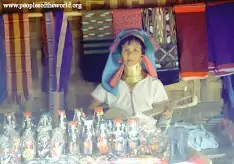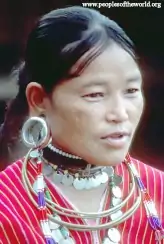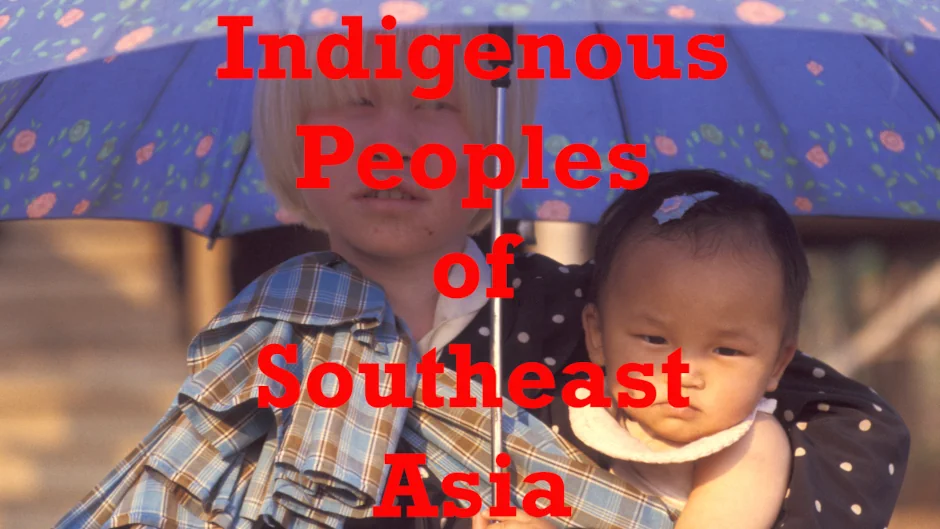The Indigenous Karen People
Ethnonyms: Ka-Kaung, Kariang, Yang Countries inhabited: Thailand, Burma (Myanmar) Language family: Tibeto-Burman Language branch: Karenic

 Most people know of the Karen people from television documentaries, magazines and encyclopedias as the
"long-neck" or "giraffe" tribe. But the women who wear these brass rings on their neck belong to a sub-group
of the Karen known as the Padaung. There are other sub-groups who do not and never have practiced this custom.
A further myth is that these rings act to elongate the wearer's neck. Any chiropractor or orthopedic
surgeon will tell you that this would lead to paralysis or death. In fact the appearance of a longer neck
is a visual illusion. The weight of the rings pushes down the collar bone, as well as the upper ribs,
to such an angle that the collar bone actually appears to be a part of the neck.
Most people know of the Karen people from television documentaries, magazines and encyclopedias as the
"long-neck" or "giraffe" tribe. But the women who wear these brass rings on their neck belong to a sub-group
of the Karen known as the Padaung. There are other sub-groups who do not and never have practiced this custom.
A further myth is that these rings act to elongate the wearer's neck. Any chiropractor or orthopedic
surgeon will tell you that this would lead to paralysis or death. In fact the appearance of a longer neck
is a visual illusion. The weight of the rings pushes down the collar bone, as well as the upper ribs,
to such an angle that the collar bone actually appears to be a part of the neck.
There are many different accounts of why the Padaung practice this bizzare custom. Their own mythology explains that it is done to prevent tigers from biting them. Others have reported that it is done to make the women unattractive so they are less likely to be captured by slave traders. The most common explanation, though, is the opposite of this — that an extra-long neck is considered a sign of great beauty and wealth, and that it will attract a better husband. Adultery, though, is said to be punished by removal of the rings. In this case, since the neck muscles will have been severely weakened by years of not supporting the head and the neck, a woman must spend the rest of her life lying down. According to Paul and Elaine Lewis in Peoples of The Golden Triangle, adultery and divorce among all Karen groups is extremely low.
 Whatever the origin of the custom is, one of the more common reasons it
continues today, particularly in Thailand, is tourism. Although the Padaung
have migrated to Thailand in only the last ten years (other
Karen groups first settled there about a hundred and fifty years ago), they
have become the most popular "attraction" for hill-tribe trekking tourists.
Some have written of this as exploitation of the Padaung; many westerners I
have spoken to liken the experience of visiting one
of these villages to visiting a human zoo. Some tour operators in Thailand
now refuse to take tourists into such villages, while some tourists boycott
those operators that do.
Whatever the origin of the custom is, one of the more common reasons it
continues today, particularly in Thailand, is tourism. Although the Padaung
have migrated to Thailand in only the last ten years (other
Karen groups first settled there about a hundred and fifty years ago), they
have become the most popular "attraction" for hill-tribe trekking tourists.
Some have written of this as exploitation of the Padaung; many westerners I
have spoken to liken the experience of visiting one
of these villages to visiting a human zoo. Some tour operators in Thailand
now refuse to take tourists into such villages, while some tourists boycott
those operators that do.
 Perhaps because the neck ring custom is so striking, less attention gets
paid to other aspects of Karen culture. Among others, though, large earrings
play a dominant role in ornamentation. Although not as visually striking
as the apparent neck-stretching, the so-called "big-eared" Karen actually
alter their body to a greater extent. As with the wearing of neck rings,
the lady on the left will have first had a much smaller earring placed in
her earlobe as a young child. As these are replaced over the years by successively
larger rings, the earlobes are stretched by a relatively huge amount. Making
music also plays an important part in Karen life and women like the one
above right can be seen playing the guitar in just about every village. The Karen
are also masters when it comes to training elephants.
Perhaps because the neck ring custom is so striking, less attention gets
paid to other aspects of Karen culture. Among others, though, large earrings
play a dominant role in ornamentation. Although not as visually striking
as the apparent neck-stretching, the so-called "big-eared" Karen actually
alter their body to a greater extent. As with the wearing of neck rings,
the lady on the left will have first had a much smaller earring placed in
her earlobe as a young child. As these are replaced over the years by successively
larger rings, the earlobes are stretched by a relatively huge amount. Making
music also plays an important part in Karen life and women like the one
above right can be seen playing the guitar in just about every village. The Karen
are also masters when it comes to training elephants.
 One Karen tradition that survives very prominently today is the making
of their own and their fiancé's wedding clothes by young women. Most unmarried
Karen women and girls wear a white robe to indicate that they are as yet
unmarried. However, as soon as a union is approved (or, sometimes even before
that, in preparation), the girl will begin weaving a different colored dress
for her wedding day. In contrast to the
Akha, Karen society is matrilineal.
The incest taboo is therefore enforced more along the maternal lines of the prospective couple's ancestry. Successive
marriages within a matrilineage in particular are discouraged. Marriage itself is considered
a very important part of a woman's life; so much so, in fact, that if a woman
dies before marriage, she is nonetheless buried (or cremated) in married
women's clothing. This, they believe, reduces the chances of malevolent
spirits preventing her from entering the afterlife.
One Karen tradition that survives very prominently today is the making
of their own and their fiancé's wedding clothes by young women. Most unmarried
Karen women and girls wear a white robe to indicate that they are as yet
unmarried. However, as soon as a union is approved (or, sometimes even before
that, in preparation), the girl will begin weaving a different colored dress
for her wedding day. In contrast to the
Akha, Karen society is matrilineal.
The incest taboo is therefore enforced more along the maternal lines of the prospective couple's ancestry. Successive
marriages within a matrilineage in particular are discouraged. Marriage itself is considered
a very important part of a woman's life; so much so, in fact, that if a woman
dies before marriage, she is nonetheless buried (or cremated) in married
women's clothing. This, they believe, reduces the chances of malevolent
spirits preventing her from entering the afterlife.

 Karen life, both in their own mythology and historical reality, is pervaded with persecution.
Their folk history speaks of them as orphans who lost their writing system
after God handed it down to them, but will have it returned one day by visitors
from a far away land. Apparently, when they first came into contact with Christian
missionaries, many Karen thought this promise of their history had finally
been fulfilled. Marshall (see References below), who was
among the first missionaries to study the Karen in great depth, says
that over two hundred folk stories had been preserved through oral history.
Despite that preservation of their history, though, it is still debated as
to where and when they originated. Although most writers now claim Burma
to be their ancestral home, many have pointed to some of their oral history
suggesting that their true origin is China.
Karen life, both in their own mythology and historical reality, is pervaded with persecution.
Their folk history speaks of them as orphans who lost their writing system
after God handed it down to them, but will have it returned one day by visitors
from a far away land. Apparently, when they first came into contact with Christian
missionaries, many Karen thought this promise of their history had finally
been fulfilled. Marshall (see References below), who was
among the first missionaries to study the Karen in great depth, says
that over two hundred folk stories had been preserved through oral history.
Despite that preservation of their history, though, it is still debated as
to where and when they originated. Although most writers now claim Burma
to be their ancestral home, many have pointed to some of their oral history
suggesting that their true origin is China.
The different Karen sub-groups historically have not recognized each
other as belonging to the same group until very recently.
Their languages/dialects are not spoken or understood by each other
and none has a collective term for all the Karen sub-groups.
Even their laguages had eluded linguistic classification
until they were finally classified as a branch of their own, namely "Karenic."

 In fact the term "Karen" itself was considered a derogatory term in Burma
until Christian missionaries brought respect to it in the late eighteenth
century.
It has been mainly the S'gaw sub-group that has considered themselves
the guardian of Karen culture.
In fact the term "Karen" itself was considered a derogatory term in Burma
until Christian missionaries brought respect to it in the late eighteenth
century.
It has been mainly the S'gaw sub-group that has considered themselves
the guardian of Karen culture.
The Karen in Burma have suffered opression at the hands of successive regimes of that country for decades. Forced re-settlement and labor, incarceration, denial of political representation and citizenship status rights among other human rights violations have led thousands of Karen to move into Thailand. While many argue that they have a better life there, their status is yet unsure. Many of them are in Thailand as refugees.
 The following quotes are taken from the Human Rights Watch World Report
2002: "Villagers continued to be forcibly relocated, and those suspected
of aiding guerrillas were tortured and sometimes killed. In January, government
soldiers extrajudicially executed three ethnic minority Palaung men in Ho
Ha village in Shan State after a search
for weapons turned up an old carbine rifle that villagers used for hunting."
"In January, the [Burmese] army reportedly displaced some 30,000
villagers in Karen State when it burned villages in its dry season offensive
against the insurgent Karen National Union."
The following quotes are taken from the Human Rights Watch World Report
2002: "Villagers continued to be forcibly relocated, and those suspected
of aiding guerrillas were tortured and sometimes killed. In January, government
soldiers extrajudicially executed three ethnic minority Palaung men in Ho
Ha village in Shan State after a search
for weapons turned up an old carbine rifle that villagers used for hunting."
"In January, the [Burmese] army reportedly displaced some 30,000
villagers in Karen State when it burned villages in its dry season offensive
against the insurgent Karen National Union."
Photography copyright © 1999 - 2026, Ray Waddington. All rights reserved. Text copyright © 1999 - 2026, The Peoples of the World Foundation. All rights reserved.

Waddington, R. (2002), The Indigenous Karen People. The Peoples of the World Foundation. Retrieved January 7, 2026, from The Peoples of the World Foundation. <https://www.peoplesoftheworld.org/text?people=Karen>
Web Links Don't Fence Me In: Major Mary and the Karen Refugees from Burma God's Army: The Real Story (video) Books Marshall, H. I., (1922) The Karen of Burma. Bangkok: White Lotus (Reprinted, 1997).


